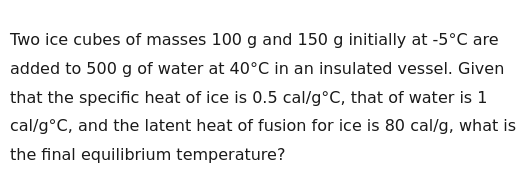Question
Question: Two ice cubes of masses 100 g and 150 g initially at -5°C are added to 500 g of water at 40°C in an ...
Two ice cubes of masses 100 g and 150 g initially at -5°C are added to 500 g of water at 40°C in an insulated vessel. Given that the specific heat of ice is 0.5 cal/g°C, that of water is 1 cal/g°C, and the latent heat of fusion for ice is 80 cal/g, what is the final equilibrium temperature?

0°C
Solution
The problem involves heat transfer between water and ice in an insulated vessel, leading to thermal equilibrium. We need to determine the final equilibrium temperature.
Let m1=100 g and m2=150 g be the masses of the two ice cubes. The total mass of ice is mi=m1+m2=100+150=250 g. The initial temperature of the ice is Ti=−5∘C. The mass of water is mw=500 g, and its initial temperature is Tw=40∘C. The specific heat of ice is si=0.5 cal/g∘C. The specific heat of water is sw=1 cal/g∘C. The latent heat of fusion of ice is Lf=80 cal/g.
According to the principle of calorimetry, the heat lost by the hot body (water) is equal to the heat gained by the cold body (ice). The final equilibrium temperature, Tf, will be between the initial temperatures of the substances. Since ice is present, Tf can be 0°C (if some ice remains) or above 0°C (if all ice melts).
First, let's calculate the heat required to bring the ice from -5°C to 0°C. Q1=mi×si×(0−Ti)=250×0.5×(0−(−5))=250×0.5×5=625 cal.
Next, let's calculate the heat required to melt all the ice at 0°C. Q2=mi×Lf=250×80=20000 cal.
The total heat required to bring the ice from -5°C to water at 0°C is Qice_to_water_at_0=Q1+Q2=625+20000=20625 cal.
Now, let's calculate the maximum heat that can be released by the water if it cools down from 40°C to 0°C. Qwater_to_0=mw×sw×(Tw−0)=500×1×(40−0)=500×40=20000 cal.
We compare the heat required by the ice to melt completely (20625 cal) with the maximum heat available from the water by cooling to 0°C (20000 cal). Since Qwater_to_0<Qice_to_water_at_0, the water does not have enough heat to melt all the ice. This means that the final equilibrium temperature will be 0°C, with some ice remaining unmelted.
At equilibrium, the system will be a mixture of water and ice at 0°C. The heat supplied by the water as it cools from 40°C to 0°C is 20000 cal. This heat is used to first raise the temperature of the ice from -5°C to 0°C, which requires 625 cal. The remaining heat available for melting the ice at 0°C is Qavailable_for_melting=Qwater_to_0−Q1=20000−625=19375 cal. The mass of ice that melts is mmelted=LfQavailable_for_melting=8019375=242.1875 g. The initial mass of ice was 250 g. The mass of ice remaining is 250−242.1875=7.8125 g. The final state consists of 500 g of original water, 242.1875 g of melted ice (now water), and 7.8125 g of ice, all at 0°C. Thus, the final equilibrium temperature is 0°C.
